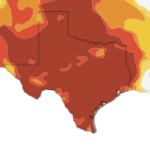Your Summer Report Card: Not as Hellish as Last Year, But a Barely Passing Grade

Photo by Tim Boyle/Getty Images
Texas had decent rain this summer, but its high temperatures aren't a good sign.
As a cold front made its way to Texas this weekend, you may have noticed a shift in habits. AC-addled couch-surfers took to their bikes for the first time in weeks, joggers weren’t relegated to nocturnal runs, and al fresco seating at bars and cafes was suddenly at a premium. Summer is over for Texas, so perhaps it’s time to take stock of how our season fared.
If you were to give the summer a grade, you’d probably have to do it in two subjects: heat and precipitation. For the latter, we’d give it a solid ‘B.’ Victor Murphy, meteorologist with the National Weather Service, tells StateImpact Texas that the state had 6.71 inches of rainfall this summer, while the average over the last hundred years is 7.59 inches. “So, as a whole, we were 0.88″ below normal, or about 12% less than normal,” Murphy says in an email. “This comes on the heels of the driest summer ever on record in 2011.” That summer the state only had 2.48 inches of rain.
But when it comes to heat, the GPA quickly declines.
While this summer was nowhere near as bad as last when it comes to heat, don’t be fooled into thinking it was a big turn for the better. Last year Austin had 90 days of 100 degree temps or higher. This year? 35. Not so bad, in comparison. But the historical average is only 13 days of 100 degrees or higher.
Murphy says 2012 was the tenth warmest summer on record in the state of Texas, with an average temperature of just over 83 degrees. That’s 1.7 degrees Fahrenheit warmer than normal. “It is worth noting that each of the past four summers in Texas have been above the top 17 warmest, dating back to 1895,” Murphy says.
If you were thinking last summer’s heat was a major anomaly, then this trend doesn’t look good. “Between 1898 and 1997, there was a 3 in 100 chance (3 percent) of a particular year being in the top 10 for the number of 100 degree days on record,” Murphy says. “Over the past 15 years, that number has risen exponentially to 7 in 15 (almost 50 percent).”
Murphy adds that the so far, 2012 has been the third warmest year on record in Texas, from January to August. The two previous records? 2000 and, yes, you guessed it, 2011.
But the meteorologist does seem some relief possible on the horizon. “El Nino conditions are still forecast to develop across the equatorial waters of the central Pacific Ocean later this month,” he says. “This should bring an increased chance for above normal precipitation for Texas, mainly during the winter months.” And there’s a chance it could bring cooler temperatures, too.




